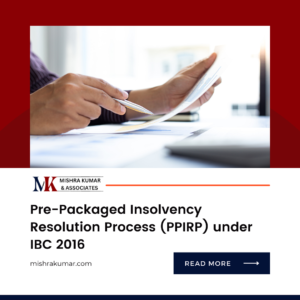
Pre-Packaged Insolvency Resolution Process (PPIRP) under IBC 2016
The Insolvency and Bankruptcy Code (IBC) 2016, is a comprehensive legislation aimed at consolidating and amending laws relating to reorganization and insolvency resolution in India. One of the notable mechanisms introduced under the IBC framework is the Pre-Packaged Insolvency Resolution Process (PPIRP). This mechanism is designed to provide a faster, more efficient, and less disruptive means of resolving insolvency, particularly for micro, small, and medium enterprises (MSMEs).
Pre-Packaged Insolvency Resolution Process (PPIRP) under IBC 2016
The Insolvency and Bankruptcy Code (IBC) 2016, is a comprehensive legislation aimed at consolidating and amending laws relating to reorganization and insolvency resolution in India. One of the notable mechanisms introduced under the IBC framework is the Pre-Packaged Insolvency Resolution Process (PPIRP). This mechanism is designed to provide a faster, more efficient, and less disruptive means of resolving insolvency, particularly for micro, small, and medium enterprises (MSMEs).
What is Pre-Packaged Insolvency?
A pre-packaged insolvency resolution process (PPIRP) is a hybrid framework that combines the advantages of informal and formal insolvency proceedings. In a pre-packaged process, the resolution of the company’s debt is negotiated and finalized between the debtor and creditors before formal insolvency proceedings are initiated in court. Once these negotiations are concluded, the plan is submitted for formal approval and implementation under the IBC framework.
Key Features of PPIRP:
- Hybrid Framework: Combines informal out-of-court negotiations with formal court processes.
- Speed and Efficiency: Aims to resolve insolvency faster than the traditional Corporate Insolvency Resolution Process (CIRP).
- Debtor-In-Possession: Allows the existing management to retain control of the company during the insolvency process.
- Creditor Consent: Requires approval from a majority of the creditors before proceeding.
- Moratorium: Provides a moratorium on legal actions against the company once the process is initiated.
- MSME Focused: Initially targeted at MSMEs, with potential for broader application in the future.
Legal Framework:
Eligibility and Initiation:
- Eligible Corporate Debtor: The company must be classified as an MSME under the Micro, Small and Medium Enterprises Development Act, 2006.
- Initiation: The PPIRP can be initiated by the corporate debtor with the approval of at least 66% of its financial creditors.
Process Overview:
- Preparation: The debtor and creditors negotiate and finalize a resolution plan before initiating the PPIRP.
- Application: The corporate debtor files an application to the National Company Law Tribunal (NCLT) along with the pre-agreed resolution plan.
- Moratorium: Upon admission of the application by NCLT, a moratorium is imposed, preventing any further legal action against the debtor.
- Management Control: The existing management remains in control of the company during the process, unlike the CIRP where a resolution professional takes over.
- Approval: The NCLT reviews and approves the pre-packaged resolution plan if it meets all statutory requirements.
Benefits of PPIRP::
- Reduced Time and Costs: The pre-negotiation of the resolution plan significantly cuts down the time and costs associated with the insolvency process.
- Business Continuity: Allows the company to continue operations with minimal disruption, preserving value and jobs.
- Creditor Involvement: Ensures creditor participation and consent from the outset, leading to more viable resolution plans.
- Less Litigation: Reduces litigation and disputes by resolving key issues in advance.
- Flexibility: Provides flexibility in structuring the resolution plan to meet the specific needs of the business and its creditors.
Challenges and Considerations:
- Stakeholder Coordination: Achieving consensus among creditors can be challenging.
- Transparency: Ensuring transparency and fairness in the negotiation process is critical.
- Regulatory Oversight: The NCLT’s role in scrutinizing and approving the pre-packaged plan remains crucial to prevent abuse.
- Scalability: While initially focused on MSMEs, extending PPIRP to larger companies may require additional safeguards and adaptations.
Conclusion:
The introduction of the Pre-Packaged Insolvency Resolution Process under the IBC 2016 marks a significant step towards enhancing the efficiency and effectiveness of insolvency resolution in India. By balancing the interests of debtors and creditors and providing a streamlined framework, PPIRP has the potential to improve outcomes for distressed companies, particularly MSMEs, and contribute to the overall health of the Indian economy. As the process evolves, it will be essential to address challenges and refine the framework to ensure its success and scalability.


Pre-Packaged Insolvency Resolution Process (PPIRP) under IBC 2016



SEBI (Delisting of Equity Shares) Regulations, 2021-Imposes new responsibilities on the board of directors.
